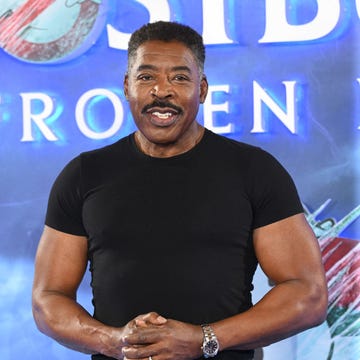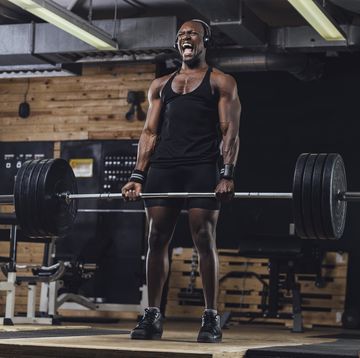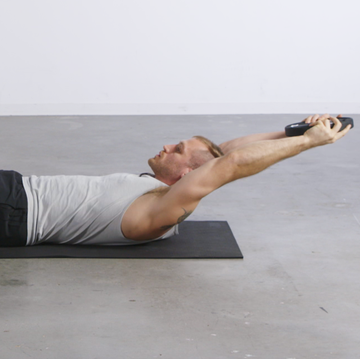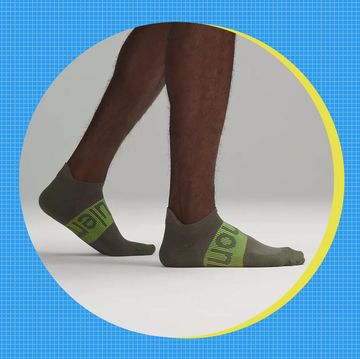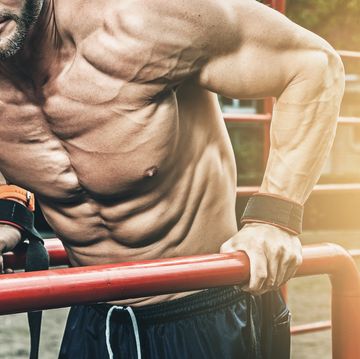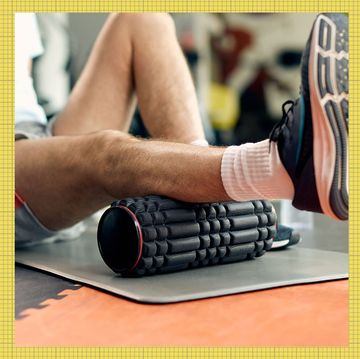Spend enough time on the Internet, and you’ll come across two strains of fitness information. There’s the hardass wing, where trainers claim, with militant certainty, that anybody can do anything. Deadlift double your body weight? Squat butt-to-calves? Bench press with two wheels on each side? You just have to want it bad enough.
Guys who follow advice like this discover a fundamental truth sooner or later: While the brain gets a vote, the body retains veto power.
Those who get the memo about their limitations often scurry to the opposite side of the industry, where you can find countless articles about how to train for your body type. The idea is that the shape of your body determines not only how good, bad, or ridiculous you look in a Speedo, but also how you should approach the process of getting into better shape.
Related: The Anarchy Workout—one guy lost 18 pounds of pure fat in just 6 weeks!
Curiously, those who promote this notion are convinced humans have just three or four basic shapes. Most go with the classic somatotypes: ectomorph (skinny), endomorph (big-boned), and mesomorph (the guy who never worries about his body type because everything he does seems to work).
Women may find different nomenclature, like pear (bottom-heavy), ruler (narrow hips and shoulders), hourglass (yes!), or apple (more in the middle). But it’s the same concept: Your workout isn’t working because it’s not custom-tailored to your unique dimensions.
Strength coach Alexander Juan Antonio Cortes was curious about the origins of the three somatotypes. As he explained in this article, the original idea had nothing to do with fitness or weight loss. Instead, it was the foundation of “constitutional psychology,” a mostly discredited science that equated body shape with intelligence, temperament, and overall value to society. (It’s also been partially supported, since mesomorphs, the lucky bastards with naturally muscular physiques, tend to have better athletic and reproductive success, leading to more career options and higher income.)
Related: 6 Insanely Fit Guys Reveal One Thing They Do Every Day
What does body type have to do with your workouts? If you’re talking about the basic design of your program, nothing. But when it comes to exercise selection, all of us need to tweak things to accommodate our bodies’ unique dimensions, structural challenges, and occasional asymmetries.
“Training is absolutely not a black and white concept, like many feel it should be,” says Dean Somerset, CSCS, a trainer and rehab specialist based in Edmonton. That’s true for any athletic pursuit or training goal, but he says it’s especially important when it comes to exercise selection. “You have to see how the person does with the exercise to gauge whether it would work for them or not.”
Let’s explore.
Lower body
In a recent post Somerset explained that nobody’s hip joints are exactly the same as anybody else’s. (Proving that, yes, you really are a special snowflake.) Some hip sockets are deeper. The femoral neck, the piece at the top of the thigh that fits into the socket, can be relatively thick or thin. The angle of the neck, in relation to the shaft of the thighbone, can also be dramatically different from one person to the next.
And most mind-blowing of all: These things can be slightly different on the left and right sides of the same person.
All these nuances, invisible for the outside, affect your range of motion on squats. “Some people won’t ever squat ass-to-grass due to their hip anatomy,” Somerset says. “But that doesn’t mean they should never squat, or would always have pain with squats.”
What is true is that the anatomy you bring into the weight room is the anatomy you were born with, and will always have. If it limits the depth of your squats, so be it. Somerset has range-limited clients squat to a box, and says they still develop leg strength without pain.
Related: 4 Exercises You Should Do Every Day
When it comes to performance in the squat, Cortes notes that anatomy very much matters. Those with shorter legs and wider hips won’t often win a footrace, but they have a big advantage in lower-body strength and muscle development. “Wider hips can simply support a lot more weight,” he says, and shorter legs cut the range of motion.
Conversely, a guy with longer legs is going to have to descend farther when he squats, and has a much longer range of motion on his deadlifts. There’s more that can go wrong, and more potential stress on the most vulnerable joints in the lower back.
Squat Rx
The barbell squat allows you to use more weight, and thus develop more strength and mass, than any other variation. But for many lifters—those with unusually long legs, or limited hip mobility, or lingering knee or lower-back problems—it can create more problems than it solves.
Solution 1: Anyone can do a goblet squat. The goblet squat, with a dumbbell or kettlebell, is the ideal entry-level variation, and is a great choice when returning from a layoff or injury. It helps you figure out your natural range of motion with minimal risk of injury.
Related: The Right Way to Do a Goblet Squat
Solution 2: Try a variety of foot positions to find the best one for you. The width of your stance, and whether you turn your toes out or keep them pointed straight ahead, is a matter of personal comfort. Keep in mind that your stance doesn’t have to be perfectly symmetrical. You may find it feels better to turn one foot out slightly more than the other.
Deadlift Rx
Hip structure can also affect your ability to lift a heavy weight off the floor. With limited hip mobility, your lower back may flex—that is, go into a deeper arch—instead of remaining in the neutral position. Rather than risk injury, Somerset says you need to find a way to shorten the range of motion. Your options include:
Solution 1: Lift from blocks. You can start with a loaded barbell set up on one or two weight plates on each side, cutting the distance you have to lift by an inch or two. If that isn’t enough, you can put it on boxes or the bottom rails of a squat rack, raising it to mid-shin level.
Solution 2: Use the high handles of a hex bar. With a 45-pound plate on each side, a barbell sits about 9 inches above the floor. Same with the low handles of a hex bar. The high handles cut the range of motion by 3 to 4 inches.
Related: 5 Normal-Sized Guys Who Are Freakishly Strong Tell You How They Did It
Solution 3: Use the sumo deadlift. The wide stance, in effect, shortens your legs, while also allowing you to lift from a more upright posture.
Upper body
Everything you just read about the hips also applies to the shoulders. Structural anomalies in the glenohumeral joint, which connects the ball at the top of your upper arm to a shallow socket in your shoulder blade, can make pressing exercises unproductive at best, injurious at worst.
At the top of the shoulder blade, directly above the joint, is a piece of bone called the acromion. Forty percent of us have what’s called a type 3 acromion, with a sharp hook that appears designed to stab anything that tries to get past it. It’s linked to a higher risk for shoulder impingement and rotator cuff tears. Years of heavy bench and shoulder presses can you leave you with chronic pain.
For performance, Cortes says, the length of your arms and the width and thickness of your torso can make a huge difference. The guy with a barrel chest and alligator arms may struggle to find a suit that fits, but “pressing is generally going to be a strong pattern.” The shortened range of motion helps with chinups and dips as well as bench and overhead presses.
Related: The 15 Best Exercises for Your Chest
At the other end of the spectrum is a guy with long arms and a narrow torso, when viewed from the side. The arm length increases the range of motion on all upper-body exercises, and the two traits conspire to make bench presses an exercise in frustration.
But long arms give you a big advantage in the deadlift. Your hands are closer to the bar, which shortens your range of motion because you don’t have to bend over as far. And on pulling exercises like rows, Cortes notes that the longer range of motion can actually be an advantage: “With long arms comes increased time under tension,” he says, with minimal joint stress.
And although this is subjective, Cortes believes longer-armed lifters can get a better sense of their back muscles working on pulls, leading to more complete muscle activation.
Shoulder press Rx
Somerset compares overhead pressing to the last woman left in the bar at closing time: Just because going home with her is an option doesn’t mean it’s a good choice. If traditional shoulder presses cause discomfort, he recommends these options:
Solution 1: Half-kneeling dumbbell overhead press. Use a single dumbbell, held on the same side as your support knee, and press slowly.
Solution 2: Neutral grip dumbbell press. Seated or standing, hold the dumbbells so they’re parallel to each other, with your elbows forward instead of flared out to the side. This creates more room for the arm to move without getting fish-hooked by the acromion.
Solution 3: Narrow grip barbell press. By holding the bar with your hands just above your shoulders, rather than outside of them, you can keep your elbows pointed forward on the way up and the way down.
Bench press Rx
Shoulder joints are like a carpet: If you only walk on one part, eventually you’ll wear a path in the part of you overuse, shortening the life of the carpet despite the fact most of it is still in good shape. It’s called pattern overload, and the barbell bench press is a notorious overloader of your shoulder joints. Here’s how to spread the stress around.
Solution 1: On the barbell bench press, change grips often. Somerset says going from wide to narrow grips, and to various points in between, helps reduce excessive wear and tear.
Related: 5 Bodybuilding Techniques That Have Stood the Test
Solution 2: With dumbbells, switch to a neutral grip. As with the shoulder press, Somerset says you’ll open more space in your shoulder joints when the weights are facing each other and your elbows are aligned with your torso, rather than perpendicular to it.
Avoiding type hype
Let’s return to the idea of “body type workouts,” especially the notion that the shape of your body, viewed from the outside, should somehow determine how you design your workouts. Ultimately, the process of getting bigger, leaner, and/or stronger is exactly the same. The basic movements patterns—squats, deadlifts, presses, rows, and chinups and pullups—are still the best tools to get the best physique possible.
But each of us has anatomical quirks that change the ways our bodies perform those movements. Along with the visible ones we discussed—long or short arms or legs, thick or thin torso—are structural challenges within the hip and shoulder joints that can limit range of motion in squats and deadlifts and literally tear shoulders apart after a few years of heavy chest and shoulder presses.
Maybe it’s disappointing to learn you’ll never squat below parallel, or that you simply can’t do barbell bench presses without pain. But knowing your body is a lot better than the alternative. “It allows you to make more informed training decisions and recognize the potential for injury,” Cortes says.
Fewer injuries mean more training and better training, which help you look better and feel better. No matter your body type.

